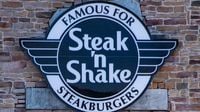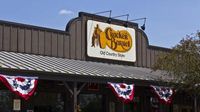Cracker Barrel, the beloved Southern country-themed restaurant chain, has found itself in the midst of a heated public debate after unveiling a new logo that strips away a key piece of its visual heritage. The change, announced on August 19, 2025, marks the first time since 1977 that the company’s branding will not feature the iconic image of a man—known to many as "Uncle Herschel"—resting beside a wooden barrel. Instead, the new logo opts for a streamlined, text-only design that highlights the restaurant’s name in brown lettering, bordered in the classic gold and brown hues that have long defined the brand’s look.
The reaction was swift and, in many quarters, intense. On August 21, Steak 'n Shake, another storied American restaurant chain, publicly criticized Cracker Barrel’s CEO, Julie Felss Masino, accusing her of erasing the chain’s heritage and identity. In a pointed post on the social platform X, Steak 'n Shake declared, “Sometimes, people want to change things just to put their own personality on things. At [Cracker Barrel], their goal is to just delete the personality altogether. Hence, the elimination of the ‘old-timer’ from the signage.” The post went on to assert, “Heritage is what got Cracker Barrel this far, and now the CEO wants to just scrape it all away. At Steak 'n Shake, we take pride in our history, our families, and American values. All are welcome. We will never market ourselves away from our past in a cheap effort to gain the approval of trend seekers.” According to Fox Business, this wasn’t the first time Steak 'n Shake had weighed in; the day before, the Indianapolis-based burger chain had replied to a post by Trump advisor Alex Bruesewitz, accusing Cracker Barrel’s board of not respecting its “historical customers” or “brand.”
But Steak 'n Shake wasn’t alone in voicing concern. Social media lit up with reactions—some mournful, some outraged, and a few supportive. One Instagram user lamented, “The new rebrand took the feeling away. Cold and sterile.” Others were even more dramatic, with a commenter writing, “I’m feeling like this new logo is ruining my life.” On the other side of the spectrum, a few customers cheered the change: “Cheers to the new logo!!!! We love you!”
The controversy quickly took on a political tone. Conservative critics compared the move to Bud Light’s recent marketing missteps, dubbing it Cracker Barrel’s “Bud Light moment.” Right-wing commentator Matt Walsh called the new logo “more generic,” while Donald Trump Jr. questioned the company’s motives, suggesting the logo might be an attempt to align with diversity, equity, and inclusion initiatives. Brand strategist Kelly O’Keefe, as quoted by CBS News, offered a more measured perspective: “In a normal marketing environment, this would not even be noticed, but these are not normal times. Politically inert marketing moves are being labeled as political for opportunistic reasons.”
Marketing experts were divided as well. Kevin Dahlstrom, founder of Bolt Health and a veteran chief marketing officer, described the rebrand as a “fiasco,” arguing on social media that, “The holy grail of marketing is to create a brand that customers give a damn about — and feel some ownership of. It’s exceedingly rare and when you have that — as Cracker Barrel did — you NEVER EVER abandon it, you only double down on it.”
Cracker Barrel, for its part, defended the decision. In an August 18 press release, the company stated that the new logo is “rooted even more closely to the iconic barrel shape and word mark that started it all.” CEO Julie Felss Masino, in an August 19 interview on "Good Morning America," sought to reassure fans: “Cracker Barrel needs to feel like the Cracker Barrel for today and for tomorrow – the things that you love are still there. We need people to choose us, and we want people to choose us.” The company also emphasized that Uncle Herschel will remain "front and center in our restaurants and on our menu," insisting, “Our values haven’t changed, and the heart and soul of Cracker Barrel haven’t changed.”
Despite these assurances, the financial markets reacted sharply. On August 21, Cracker Barrel’s stock fell $4.22, or 7.2%, to $54.80, erasing approximately $94 million in market value. At one point during the day, the stock had dipped even further, representing a nearly $200 million loss in capitalization. According to Fox Business, this marked the steepest drop in Cracker Barrel shares since April. The following day, the stock appeared to stabilize, rising about 1.3% by midday. Still, the episode was a stark reminder of how a branding decision—especially one that touches on nostalgia and identity—can reverberate beyond the marketing department and into the boardroom.
The logo change comes as part of a broader effort by CEO Masino to refresh the company’s image and menu, aiming to appeal to a new generation of customers. Recent restaurant renovations, which debuted just weeks before the logo update, also faced online criticism for moving away from the chain’s "old-timey" aesthetic. According to the company’s website, the original man-and-barrel logo was meant to evoke “the old country store experience where folks would gather around and share stories.” The new design, while still featuring the interlaced "C" and "B" and classic color palette, has been described by some as “cold and sterile.”
Cracker Barrel’s financials have mirrored the turbulence of its rebranding journey. The company reported 2024 revenue of roughly $3.5 billion—a modest increase from $3.4 billion the previous year—but saw net income drop significantly, from $99 million in 2023 to $40.9 million in 2024. For its most recent quarter, revenue stood at $821.1 million, up slightly from $817.1 million the prior quarter. Notably, Cracker Barrel shares have risen 7% this year to $55.42 as of Friday morning, but the stock has fallen sharply since its 2018 peak of over $180.
Both Steak 'n Shake and Cracker Barrel are institutions with deep roots in American dining. Steak 'n Shake, founded in 1934 in Normal, Illinois, and Cracker Barrel, which opened its first store in 1969 in Lebanon, Tennessee, have each cultivated loyal followings over the decades. Their longevity is a testament to the enduring appeal of classic comfort food and a sense of tradition. Yet, as this episode demonstrates, even the most established brands are not immune to the pressures of change—or to the passions of their customers.
For now, Cracker Barrel’s new logo will appear on menus, marketing materials, and at its more than 30 locations in Ohio alone, including Cincinnati, Columbus, Mansfield, North Canton, and Zanesville. Whether the simplified design will win over the next generation or drive away longtime fans remains to be seen. But one thing’s for sure: in today’s America, even a logo can spark a national conversation about identity, nostalgia, and the future of a cherished brand.

